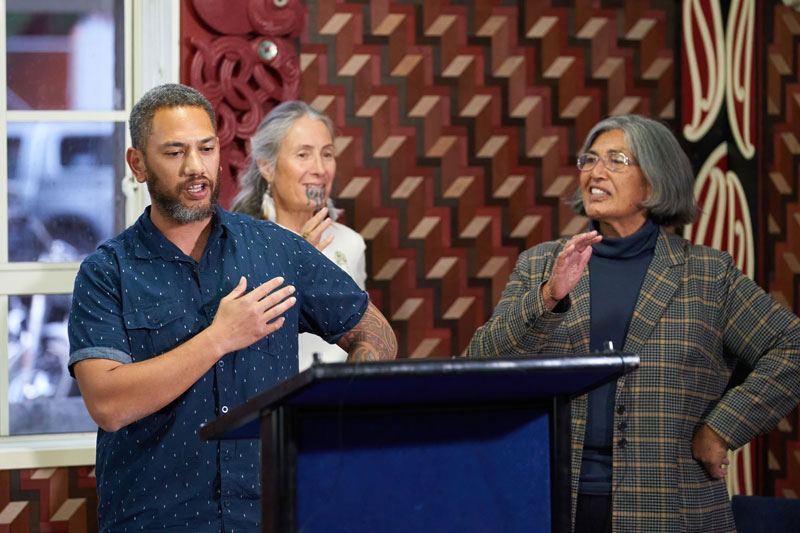
The Marine Cultural Health Programme is a kaupapa (initiative), developed in partnership between mana whenua hapū of Ahuriri and Napier Port, to monitor and protect the health of the Ahuriri marine environment as the port builds its new 6 Wharf project.
An Aotearoa New Zealand first, the Programme provides a real-time state of health and aims to help to lay the foundation for the future restoration and enhancement of this environment.
The Ahuriri marine environment is an important place for mana whenua and residents of Te Matau a Māui (Hawke’s Bay). The area contains taonga of cultural value for hapū and is the home of Pānia Reef – a site of cultural significance as the embodiment of the sea maiden Pānia, and Moremore Maitaitai Reserve at Tangoio. Pānia Reef is also an important site for gathering kaimoana as a designated mahinga mātaitai for customary fishing.
Todd Dawson, Napier Port CEO, said, “We’re building 6 wharf to support the sustainable growth of the region now and into the future. Since we first started planning our new wharf several years ago, we have made it a priority to understand the needs of our communities and shape the project accordingly.”
“We’re invested in the future of our region, and this major infrastructure project is a shining example of how we are ensuring the work we do is the best it can be for our community, environment, and economy, and with sustainability very much at its heart.”
Napier Port have invested in a large body of scientific research into Hawke’s Bay’s marine environment to ensure the 6 Wharf project is aligned with long-term sustainable goals and also followed comprehensive and best practice management plans to protect the environment. The port is also working with a Fisheries Liaison Group to ensure robust procedures are in place to manage water quality and fisheries during disposal and dredging.
Over the last year and a half, the Port have worked side-by-side with a Steering Komiti of representatives from different marae, hapū and mana whenua entities, to develop a framework for this important environmental work that is being done and create the Marine Cultural Health Programme.
At the heart of the Marine Cultural Health Programme is the Cultural Monitoring Framework (CMF) – an innovative monitoring framework that balances Western science and a Māori worldview in order to deliver mutually beneficial ecological health and cultural, or whānau wellbeing, health outcomes. The framework embodies Kaitiakitanga or guardianship, an obligation to care for the environment and maintain it for future generations.
Napier Port’s Pou Tikanga (cultural advisor) and Environmental Advisor and also Programme Manager for the Marine Cultural Health Programme, Te Kaha Hawaikirangi said, “Designing a Marine Cultural Health Programme from scratch has been a big challenge, but working closely with mana whenua marae and hapū has helped us to create a localised programme that speaks to the rich traditions of Ahuriri, its people and environment.”
“Our Cultural Monitoring Framework is an attempt to see the world through Māori eyes in a way that focuses attention on two critically important ideas. First, we recognise that spiritual (Kete Te Ao Tua Ātea), sensible (Kete Te Aronui) and energy (Kete Tua-uri) worlds are connected. Second, as Māori we share common ancestry (whakapapa) with the environment and all living things.”
The Cultural Monitoring Framework monitors health by using two Pou – Mana Moana, represents the health and wellbeing of the Ahuriri marine ecosystem, and Mana Tangata, represents the strength of connection of mana whenua to the marine environment. The framework uses a ‘family tree’ of indicators to measure qualitative and quantitative data and assess the overall health of the Ahuriri area and its people. This data is available to the public in real-time on a marine cultural monitoring website.
The Steering Komiti Chair, Chad Tareha (Ngāti Pārau Hapū Representative) said, “Napier Port sought to engage all mana whenua entities in the Steering Komiti, and this has been valuable as it has provided for diverse and meaningful dialogue in the creation of the Programme and its framework.”
“Our Cultural Monitoring Framework builds on the whakatupu mātauranga (knowledge development) experiences of mana whenua who have developed and used Cultural Health Index (CHI) monitoring tools previously. We’ve designed our Programme as a living document that will be updated annually and, hopefully, eventually become a benchmark for other mana whenua who seek to monitor their marine rohe (area),” continued Tareha.
For more information about the Marine Cultural Health Programme or to view the cultural health of the Ahuriri Marine environment in real-time visit www.marineculturalhealth.co.nz
Construction on the 6 Wharf commenced at the start of 2020 and is due to be completed at the end of 2022.
